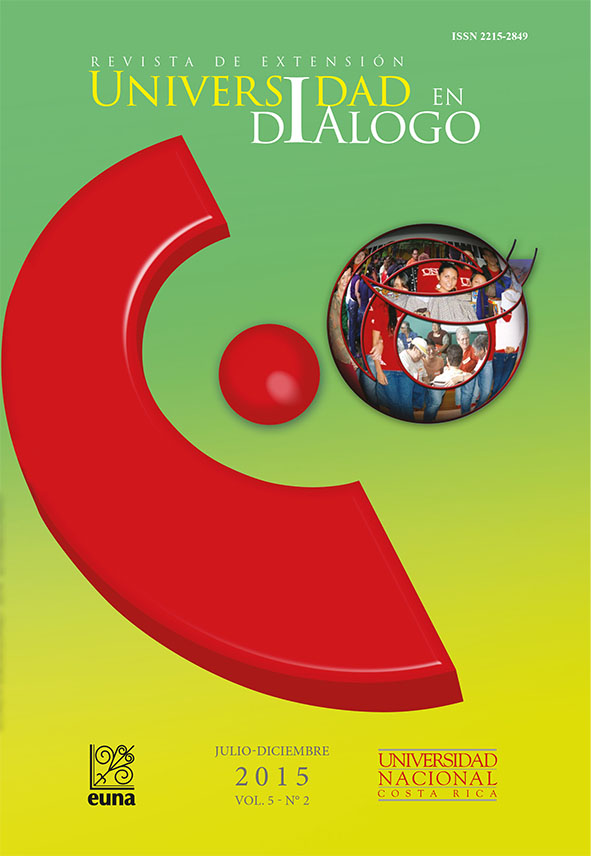The Development of an Organizational Culture that Encourages the Application of Good Management Practices Allow Outstanding Business Innovation Performance: A Theoretical Approach and Model of Teaching, Research and Outreach Adopted in the UNA-INNOVA Project of Expertise in Human Resources Management of the Universidad Nacional
Keywords:
Organizational Culture, Management Practices, Organizational Design, Bonding Teaching, Research, ExtensionAbstract
Business success is directly related to the ability to adapt and respond to the needs of the market or with their economic possibilities to fund the change through research, development and innovation. The national scene reflects a business park full of small and medium-sized companies with few possibilities to invest in I+D+I. However, the company innovation achievement goes further than managerial disposition, company strategy, external variables or the assignation of financial resources . On the contrary, it requires an organizational layout who gives enough flexibility to manage creativity and foment innovation, a well done organizational disposition leads to the development of management skills, which improve innovative progress. A correct organizational disposition that dowry of enough flexibility that allows managing creativity and encourage innovation. In agreement with Sánchez and Lopez (2013), good skills is visible, which means on one hand that it has public and institutional recognition, on the other hand it can be documented and record, cause it has positive and verifiable results. In accordance with Epper and Bates (2014), these skills may be extrapolated in different contexts. The following article summarizes the argument theoretical-methodological of project UNA-INNOVA attached to the mastery in administration of human resources of the National University, which seeks the identification and recollection of skills dedicated to outstanding management that can be emulated or contextualized by Costa Rican companies. By using the linkage teaching investigation-extension, UNA-INNOVA pretends to give a hand that helps Costa Rican companies to obtain tools that boost the change and organizational flexibility so they can confront the actual business context.References
De Pablos, J., Colás, P. y González, T. (2010). Factores facilitadores de la innovación con TIC en los centros escolares. Un análisis comparativo entre diferentes políticas educativas autonómicas. Revista de Educación, (352), 23-51.
Epper, R. y Bates, T. (2004): "Enseñar al profesorado cómo utilizar la tecnología. Buenas prácticas de instituciones líderes". Educación y Sociedad Red. Barcelona: Editorial UOC.
Gómez-Mejía, L. R., Balkin, D. y Cardy, R. (2001). Dirección y gestión de Recursos Humanos (3a. ed.). Madrid: Prentice Hall.
Grueso, M. (2010). Implementación de buenas prácticas de promoción de personal y su relación con la cultura y el compromiso con la organización. INNOVAR. Revista de Ciencias Administrativas y Sociales, 20 (36), 79-90.
Hofstede, G. (1979). Value Systems in Forty Countries: Interpretation, validation and consequences for theory. En Eckensburger, L. H. (Ed.), Cross-Cultural Contribution to Psychology (pp. 389-407). Berlin: Swets and Zeitlinger B.V.
Hofstede, G. (1991). Cultures and Organizations: Software of the mind. England: McGraw Hill Book Company Europe.
Hofstede, G. y Bond, M. (1988). The Confucius connection: from cultural roots to economic growth. Organizational Dynamics, 16 (4), 4-21.
Kopelman, R., Brief, A. y Guzzo, R. (1990). The role of climate and culture in productivity. En Schneider, B. (Ed.), Organizational Climate and Culture (pp 282-318), San Francisco: Jossey Bass Publishers.
Lucas, M. A. y García, R. P. (2002). Sociología de las organizaciones. Madrid: McGraw Hill.
Mintzberg, H (1984) The structuring of organizations (A Syntesis of research). Barcelona: Ariel Ediciones.
Mondy, W. y Noe, R. (1997). Administración de Recursos Humanos. (6ta Ed.). México D.F: Editorial Prentice Hall Hispanoamericana S.A.
Moreno-Luzón, M.D., Peris, F y González, T. (2001): Gestión de la calidad y Diseño de Organizaciones. Teoría y Estudio de Casos. Madrid: Prentice Hall.
Pugh, D.S (1973): The measurement of organization structures. Does Context determine form?, Organizational Dynamics, 1 (4)., 96-117.
Pugh, D.S y Hickinson, D.J (1996): Writers on Organizations. Londres: Penguin Books.
Robins, S.P. y Coulter, M. (1996). Comportamiento Organizacional, Teoría y Práctica. (7ta Ed). México D.F: Prentice – Hall Hispanoamericana, S.A.
Sánchez, M. y López, J. (2013) Buenas prácticas de gobierno y gestión en la universidad. Teoría Educativa, 1 (25), 125-148.
Downloads
Published
How to Cite
Issue
Section
License

La Revista y cada uno de los artículos que se publican están licenciados por Creative Commons Atribución No comercial Sin derivadas 4.0 Internacional.



